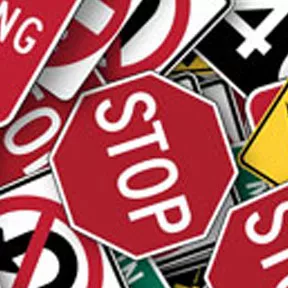Regulatory and Warning Signs

Learn about stop signs, speed limits, parking restrictions and warning signs.
The Ontario Highway Traffic Act is a set of rules that need to be followed when traveling on the road. Traffic signs tell drivers what they need to do to make sure they obey these rules and drive safely.
- Stop Signs
Stop signs tell the driver to stop and wait for traffic and pedestrians to clear the intersection before proceeding.
All-way stops are used to control traffic at busier intersections where all approaches have a similar amout of traffic volume. If you arrive at the intersection at the same time as another vehicle, the vehicle to your right goes first.
- Speed Limits
Speed limits tell you the maximum speed you are allowed to travel. The speed limit depends on how the road is designed, if it's a local or major road and what is located nearby (such as a school or park).
The City of Markham has applied 40 kilometres per hour speed limits on most local residential streets and in school zones. Busier roads may be posted at 50 kilometres per hour or higher.
- Parking Restrictions
The two most common signs are "No Parking" and "No Stopping" signs. These signs help reduce parked cars from blocking the street and allow traffic to move more smoothly. There are many parking by-laws found in Markham By-law 2005-188 [PDF].
No Parking: You can't park your car where these signs are posted. You can stop your car for a short period only to load or unload goods or passengers. You can't leave your car unattended.
No Stopping: You can't stop your car where these signs are posted, or load and unload goods or passengers. You can only stop only if directed by a police officer, stop sign or a traffic signal.
- Warning Signs
Warning signs advise drivers about conditions on or near the road that they need to be aware of. You should drive carefully and follow the sign’s instructions.
